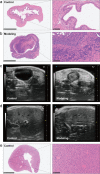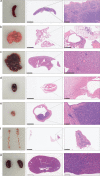Establishment of an optimized orthotopic bladder cancer model in mice
- PMID: 36057655
- PMCID: PMC9441054
- DOI: 10.1186/s12894-022-01093-6
Establishment of an optimized orthotopic bladder cancer model in mice
Abstract
Background: Bladder cancer (BC) is one of the most common malignancies of the genitourinary system. Animal models offer an important tool to explore tumour initiation, progression, and therapeutic mechanisms. Our aim is to construct an optimized orthotopic BC model which is predictable, reproducible, and convenient.
Methods: The optimized orthotopic BC model was constructed in male C57BL/6 mice utilizing microsyringes to inoculate them with a murine BC cell line (MB49). Anesthetised mice were inoculated with an MB49 cell suspension (10 µL) at approximately 5 × 106/mL. The whole process of modelling was observed and monitored every 3 days for 21 days utilizing HE staining and transabdominal ultrasonography (TUS).
Results: In this study, the model showed excellent success rates for tumour formation (96.67%) and metastatic rate (89.66%). Compared to the control group (sham operation), mice in the modelling group had serous cachexia, visible haematuresis and weight loss (all P < 0.05). The lungs, liver, ureter and kidneys were found to have tumour metastasis. Moreover, the average survival time (19.73 ± 1.69 d) of modelling mice was significantly shorter than that of the control mice (P < 0.05), which remained alive.
Conclusion: Our study established a method using microsyringes to inject murine BC cells into the bladder wall, creating a stable transplantable BC model in mice.
Keywords: Bladder cancer; MB49; Microsyringes; Orthotopic murine model.
© 2022. The Author(s).
Conflict of interest statement
All authors declared that they have no conflict of interest.
Figures








Similar articles
-
[A simple and efficient method for establishing a mouse model of orthotopic MB49 bladder cancer].Nan Fang Yi Ke Da Xue Xue Bao. 2009 Apr;29(4):627-30. Nan Fang Yi Ke Da Xue Xue Bao. 2009. PMID: 19403380 Chinese.
-
Novel invasive orthotopic bladder cancer model with high cathepsin B activity resembling human bladder cancer.J Urol. 2009 Aug;182(2):749-55. doi: 10.1016/j.juro.2009.03.076. Epub 2009 Jun 18. J Urol. 2009. PMID: 19539312
-
A novel immunotherapy for superficial bladder cancer by the immobilization of streptavidin-tagged bioactive IL-2 on the biotinylated mucosal surface of the bladder wall.Chin J Cancer. 2010 Jun;29(6):611-6. doi: 10.5732/cjc.009.10640. Chin J Cancer. 2010. PMID: 20507734
-
Optimizing syngeneic orthotopic murine bladder cancer (MB49).Cancer Res. 1999 Jun 15;59(12):2834-7. Cancer Res. 1999. PMID: 10383142
-
Mouse orthotopic models for bladder cancer research.BJU Int. 2009 Nov;104(9):1286-91. doi: 10.1111/j.1464-410X.2009.08577.x. Epub 2009 Apr 16. BJU Int. 2009. PMID: 19388981 Review.
Cited by
-
Non-Invasive Imaging Modalities in Intravesical Murine Models of Bladder Cancer.Cancers (Basel). 2023 Apr 20;15(8):2381. doi: 10.3390/cancers15082381. Cancers (Basel). 2023. PMID: 37190309 Free PMC article. Review.
-
Orthotopic and metastatic tumour models in preclinical cancer research.Pharmacol Ther. 2024 May;257:108631. doi: 10.1016/j.pharmthera.2024.108631. Epub 2024 Mar 11. Pharmacol Ther. 2024. PMID: 38467308 Free PMC article. Review.
-
Bioprinted research models of urological malignancy.Exploration (Beijing). 2024 Feb 20;4(4):20230126. doi: 10.1002/EXP.20230126. eCollection 2024 Aug. Exploration (Beijing). 2024. PMID: 39175884 Free PMC article. Review.
-
Development of Traceable Mouse Models of Advanced and Metastatic Bladder Cancer.Cancers (Basel). 2024 Jun 17;16(12):2245. doi: 10.3390/cancers16122245. Cancers (Basel). 2024. PMID: 38927950 Free PMC article.
-
Malevolent alliance of MYBL2hi cancer stem cell and SPP1+ macrophage confers resistance to neoadjuvant immunotherapy in bladder cancer.J Immunother Cancer. 2025 Jul 10;13(7):e011319. doi: 10.1136/jitc-2024-011319. J Immunother Cancer. 2025. PMID: 40639849 Free PMC article.
References
MeSH terms
LinkOut - more resources
Full Text Sources
Medical

